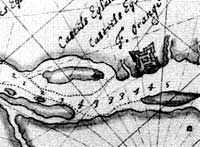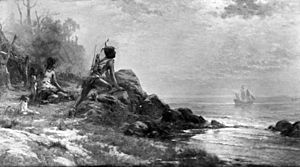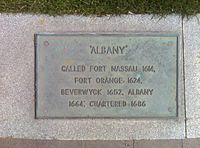History of Albany, New York (prehistory–1664) facts for kids
The early history of Albany, New York tells the story of the area before 1664. It starts with the first people who lived there and ends when the English took control of New Netherland.
Long ago, different Algonquian Indian tribes lived in this area. They had different names for the land. The Mohican people called it Pempotowwuthut-Muhhcanneuw. This means "the fireplace of the Mohican nation." The Iroquois called it Sche-negh-ta-da, which means "through the pine woods."
The first European building in Albany was a simple fort. French traders built it on Castle Island in 1540. But floods soon destroyed this fort.
Permanent European claims began in 1609. An Englishman named Henry Hudson explored for the Dutch East India Company. He arrived in the area on his ship, the Half Moon. Hudson claimed the land for the United Netherlands.
In 1614, Hendrick Christiaensen rebuilt the French fort. He named it Fort Nassau. This was the first Dutch fur trading post in what is now Albany. The fur trade caused problems with the French colony in Canada. It also caused fights among the native tribes. Everyone wanted to control the trade.
In 1618, a flood destroyed Fort Nassau. But it was rebuilt in 1624 as Fort Orange. Both forts were named after the royal Dutch House of Orange-Nassau. Fort Orange and the land around it became the village of Beverwijck in 1652. Its name means "Beaver District" in English.
The English captured New Netherland in 1664. The name Beverwijck was then changed to Albany. This was to honor the Duke of Albany. He later became King James II of England and James VII of Scotland. The title "Duke of Albany" was a Scottish title given since 1398. It was usually given to a younger son of the King of Scots. The name "Albany" comes from Alba, the Gaelic name for Scotland.
Albany's Land and Early People
Before Europeans settled, Albany was a forest along the Hudson River. It had five kills. A kill is an old Dutch word for a creek. People in Albany still use this word today. These creeks carved deep ravines. These ravines separated the hills of Albany.
Further inland was the Pine Bush. This was a large area of pine barrens. It stretched from Albany to Schenectady. As more people settled, the Pine Bush was slowly cut down. The creeks, like the Rutten, Vosen (Foxes), and Beaver kills, were put into pipes and covered. Only Patroon Creek and the Normans Kill remain today. Some ravines were also filled in over time. Sheridan Hollow and Tivoli Hollow are two ravines that are still there. Sheridan Hollow was made by the now-covered Foxen Kill. Tivoli Hollow was made by Patroon Creek. The Empire State Plaza was built in the 1970s. It filled the hollow made by the Rutten Kill. Lincoln Park is in the hollow formed by the Beaver Kill. Washington Park Lake was made by damming the last part of the Rutten Kill that was above ground.
The native people of Albany called the Normans Kill the Tawawsantha. Different tribes had different names for the Albany area. The Mohegans called it Pem-po-tu-wuth-ut. This means "place of the council fire." The Iroquois called it Sche-negh-ta-da, meaning "through the pine woods." The five creeks were first called First Kill, Second Kill, and so on. The Normans Kill got its name from Albert Andriessen Bradt. He was a Norwegian settler. The Dutch word for Norwegian was Noorman. The Rutten Kill was named for Rutgers Bleecker. He owned land along its banks a long time ago.
First European Settlements

Albany is the oldest European settlement that still exists from the original thirteen colonies. In 1540, French traders were the first Europeans to visit the area. They built a simple fort on Castle Island. This fort was on a flood plain. It was soon left empty because of damage from the yearly spring floods.
Permanent European claims started in 1609. An Englishman named Henry Hudson explored for the Dutch East India Company. He arrived in the area on his ship, the Halve Maen ("Half Moon"). In 1614, the Dutch explorer Hendrick Christiaensen rebuilt the earlier French fort. He called it Fort Nassau. This was the first Dutch fur trading post in the area. After Christiaensen died, Jacob Eelkens took charge of the fort.
The start of the fur trade caused problems with the French colony in Canada. It also caused fights among the native tribes. Everyone wanted to control the trade. The fort was again left empty because of floods. A new fort was built in 1624. It was called Fort Orange and was a bit further north. Both forts were named to honor the Dutch House of Orange-Nassau.
In 1626, the Mohawk nation from west of Albany and the Mohegan nation from the east side of the Hudson River started fighting again. Fort Orange sided with the Mohegans. As a result, six soldiers were lost in a surprise attack. This happened in what is now Lincoln Park. In 1628, the Mohawks defeated the Mohegans. They pushed them to Connecticut.
In 1642, a ferry service started to the east side of the Hudson. This was at a native settlement called Tuscameatic. The Dutch later called this place Het Green Bosch. This means "the Green Woods." This area is now the city of Rensselaer. But the name lives on in the towns of North Greenbush and East Greenbush.
The Director-General of New Amsterdam, Pieter Stuyvesant, came to Fort Orange in April 1652. He made the areas around the fort into the Village of Beverwyck. He also set up the first court in Albany around that time. A court was needed to settle a disagreement. This disagreement was between Stuyvesant and the patroonship of Rensselaerswyck. They were arguing over who had control of the land around the fort.



